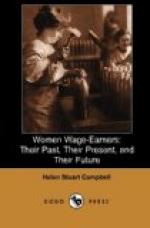Minnesota, whose first report, under the supervision of Commissioner John Lamb, appeared in 1888 for the years 1887 and 1888, found little or no room for statistics, but included a chapter on working-women, with a few admirable tables of age, nativity, home and working conditions, etc. Minute inquiry was made as to cost of living, clothing, etc.; and the results form a chapter of painful interest, that on domestic service being equally suggestive. Clothing, as usual, represents the lowest average wage, $3.66 per week, the highest being $8.50, and the general average a trifle over $6.
Michigan, in 1890, under its labor commissioner, Mr. Henry A. Robinson, added to the list one of the most thorough studies yet made of general conditions. The agents of the bureau, trained for the work, made personal visits to working-women and girls to the number of 13,436, this representing one hundred and thirty-seven distinct industries and three hundred and seventy-eight occupations. The blanks prepared for filling out contained one hundred and twenty-nine questions, classified as follows: Social, 28; industrial, 12; hours of labor, 14; economic, 54; sanitary, 21, with seven others as to dress, societies, church attendance, with remarks and suggestions from the workers themselves. As usual, in such cases, employers here and there objected to any investigation, fearing labor organizations were at the bottom of it; but the majority allowed free examination. The report is very full, and gives a clear and full view of the individual lives of this body of women workers. The average wage proved to be $4.81 per week, the average income for the year being $216.45. The average income of teachers and those in public positions was $457.27.
This is the showing, State by State, so far as bureaus have reported. Many States have made no move in this direction; but interest is now thoroughly aroused, and the subject is likely to find treatment in all, this depending somewhat, however, on the character of the State industries and the numbers at work in each. Manufacturing necessarily brings with it conditions that in the end compel inquiry; and for most of the Southern States such industries are still new, while the West has not yet found the same occasion as the East for full knowledge of the problems involved in woman’s work and wages.
We come now to the most elaborate and far-reaching inquiry yet made,—the work of the United States Bureau of Labor under Commissioner Wright, entitled “Working-Women in Large Cities.” Twenty-two of these are reported upon after one of the most rigorous examinations ever undertaken; and the average wage of each tallies with the rates given in the States to which they belong. Taken alphabetically, the list is as follows:—
Average weekly earnings, by cities.




